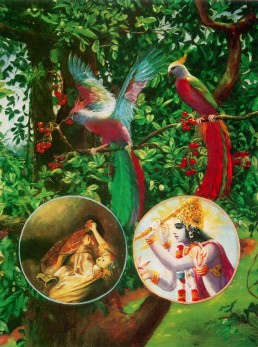Swami Chinmayananda
Swami Chinmayananda Commentary
“He, who in reality knows these two, My Vibhuti and My Yoga,” gets established in the realisation of the Supreme. We find that the terms Vibhuti and Yoga, which appear in this stanza, are invariably translated as “Manifold manifestation of beings” (Vibhuti) and “My power” (Yoga).
In effect, although these translations are true, they are not efficient enough to convey the subtle and the brilliant connection between the statement and what has been indicated in the previous stanza. Macrocosmic projection of a created Universe, through the intervention of the “Seven Seers,” is the Absolute’s own Vibhuti, while the microcosmic experience of a limited world, through the intervention of the mind-born “Four Ancient Kumaras,” is the Divine Yoga of the Self in each one of us. Since the Self, presiding over the destinies of the individual, is Itself the Absolute that forms the substratum for the entire Universe, he who realises both the Vibhuti and the Yoga as divine expressions of the Eternal, realises the Infinite.
That this understanding of the macrocosm and its influence upon the play-of-life in the field of plurality should not be merely a professor’s book-knowledge, is indicated here, when Krishna insists that the seeker must know it “in reality” (Tattwatah). This means that the above-mentioned knowledge is to be realised in a subjective experience, and intuitively lived, as “I am the Self.”
“When I play through the ‘Seven Seers’ I PAINT the Universe, and when I play through the ‘Four Ancients’ I LIVE the tearful life of an individual.” It is not then very difficult for us to feel the appropriateness of the statement in the last stanza that the Rishis, Ancients and the Manus, all “WERE BORN OF MIND.” When the Self, therefore, detaches Itself from both the INDIVIDUAL-mind and the COSMIC-mind, It comes to revel in all Its Absolute glory. Identifying Itself with the COSMIC-mind It becomes the Creator (Ishwara) CREATING THE UNIVERSE, and identifying with the individual-mind It becomes the limited ego (Jiva), SUFFERING THE LIMITED WORLD. To know this implication and to live up to this is the TREMORLESS-Yoga” — wherein a permanent and steady establishment in the experience of the Self is assured. As at many points earlier, Vyasa is making his Divine mouthpiece use the sacred word Yoga in a familiar and a daringly novel context, so that the awe and dread which had gathered round this blessed term may disappear. The “TREMORLESS-YOGA” is as novel as the various definitions of Yoga given earlier in different verses of the Geeta — the one, single, irreplaceable Bible-of-revolt in all Hindu renaissance movements.
WHAT EXACTLY IS THE TECHNIQUE BY WHICH WE CAN GET OURSELVES ESTABLISHED STEADILY AND PERMANENTLY IN THE UNBROKEN EXPERIENCE OF THE INFINITE AS OUR OWN REAL NATURE?… LISTEN:
Adi Sankara Commentary
Yah, one who; vetti, knows; tattvatah, truly, i.e. just as it is; etam, this, aforesaid; vibhutim. majesty, (divine) manifestations; [Omnipresence.] and yogam, yoga, action, My own ability to achieve [God’s omnipotence. (God’s power of accomplishing the impossible.-M.S.)]-or, the capacity for mystic powers, the omniscience resulting from yoga (meditation), is called yoga; sah, he; yujyate, becomes imbued with; avikampena, unwavering; yogena, Yoga, consisting in steadfastness in perfect knowledge. [After realizing the personal God, he attains the transcendental Reality; the earlier knowledge leads to the latter.] There is no samsayah, doubt; atra, about this. With what kind of unwavering Yoga does he become endued? This is being answered:
The Bhagavad Gita with the commentary of Sri Sankaracharya – Translated by Alladi Mahadeva Sastry
Holy Geeta – Commentary by Swami Chinmayananda
The Bhagavad Gita by Eknath Easwaran – Best selling translation of the Bhagavad Gita
The Bhagavad Gita – Translation and Commentary by Swami Sivananda
Bhagavad Gita – Translation and Commentary by Bhaktivedanta Swami Prabupadha
Srimad Bhagavad Gita Chapter 10 – Verse 7 – 10.7 etam vibhutim – All Bhagavad Gita (Geeta) Verses in Sanskrit, English, Transliteration, Word Meaning, Translation, Audio, Shankara Bhashya, Adi Sankaracharya Commentary and Links to Videos by Swami Chinmayananda and others – 10-7

